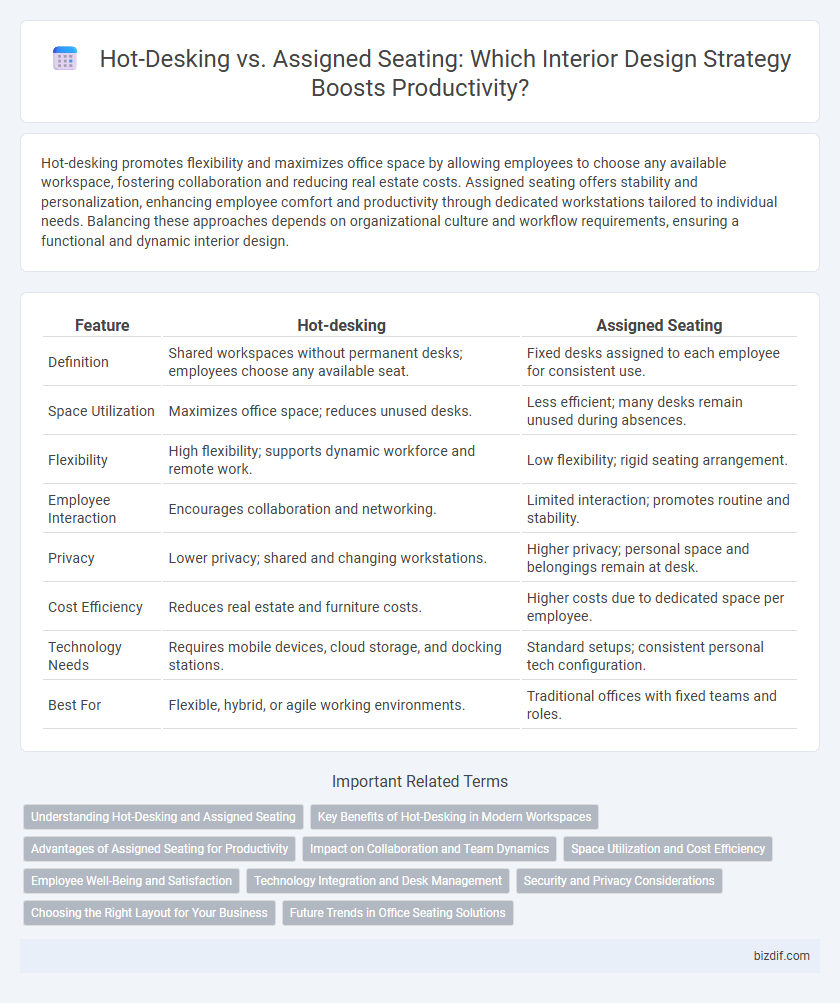Hot-desking promotes flexibility and maximizes office space by allowing employees to choose any available workspace, fostering collaboration and reducing real estate costs. Assigned seating offers stability and personalization, enhancing employee comfort and productivity through dedicated workstations tailored to individual needs. Balancing these approaches depends on organizational culture and workflow requirements, ensuring a functional and dynamic interior design.
Table of Comparison
| Feature | Hot-desking | Assigned Seating |
|---|---|---|
| Definition | Shared workspaces without permanent desks; employees choose any available seat. | Fixed desks assigned to each employee for consistent use. |
| Space Utilization | Maximizes office space; reduces unused desks. | Less efficient; many desks remain unused during absences. |
| Flexibility | High flexibility; supports dynamic workforce and remote work. | Low flexibility; rigid seating arrangement. |
| Employee Interaction | Encourages collaboration and networking. | Limited interaction; promotes routine and stability. |
| Privacy | Lower privacy; shared and changing workstations. | Higher privacy; personal space and belongings remain at desk. |
| Cost Efficiency | Reduces real estate and furniture costs. | Higher costs due to dedicated space per employee. |
| Technology Needs | Requires mobile devices, cloud storage, and docking stations. | Standard setups; consistent personal tech configuration. |
| Best For | Flexible, hybrid, or agile working environments. | Traditional offices with fixed teams and roles. |
Understanding Hot-Desking and Assigned Seating
Hot-desking involves employees using available workstations on a first-come, first-served basis, maximizing office space efficiency and fostering collaboration. Assigned seating provides designated desks for individuals, promoting personal workspace customization and improved organization. Understanding the balance between these approaches helps businesses optimize productivity and accommodate diverse work styles.
Key Benefits of Hot-Desking in Modern Workspaces
Hot-desking enhances flexibility and space efficiency by allowing employees to use any available workstation, which maximizes office utilization and reduces real estate costs. This dynamic seating arrangement fosters collaboration and innovation by encouraging spontaneous interactions among team members from different departments. Moreover, hot-desking supports hybrid work models, promoting a more adaptable and agile work environment that can easily accommodate fluctuating employee presence.
Advantages of Assigned Seating for Productivity
Assigned seating enhances productivity by providing employees with a consistent, personalized workspace that reduces distractions and fosters a sense of ownership. This stability supports better organization and efficient workflow, enabling workers to quickly access necessary tools and resources. Employees benefit from stronger team cohesion and communication when seated near relevant colleagues, boosting collaboration and task completion.
Impact on Collaboration and Team Dynamics
Hot-desking promotes dynamic collaboration by enabling employees to interact with different team members daily, fostering diverse idea exchange and innovation. Assigned seating supports stable team dynamics and deepens relationships by providing consistent proximity, enhancing focused communication and trust within groups. Balancing hot-desking and assigned seating strategies can optimize teamwork by aligning seating arrangements with project needs and collaboration intensity.
Space Utilization and Cost Efficiency
Hot-desking maximizes space utilization by allowing multiple employees to share a single workstation, reducing the need for large office footprints and lowering real estate costs. Assigned seating often results in underused desks and higher expenses due to fixed allocations, leading to inefficient space usage. Companies adopting hot-desking see improved cost efficiency through optimized resource allocation and minimized overhead for unused workstations.
Employee Well-Being and Satisfaction
Hot-desking enhances employee well-being by promoting flexibility and social interaction, reducing feelings of isolation and encouraging diverse collaboration. Assigned seating offers a sense of stability and personal space, which can improve comfort and reduce stress for individuals who prefer routine and ownership of their work environment. Balancing these seating strategies can optimize employee satisfaction by addressing various work styles and psychological needs within interior design.
Technology Integration and Desk Management
Hot-desking leverages advanced technology integration such as AI-powered desk management systems and mobile apps for real-time desk availability, optimizing space utilization and enhancing employee flexibility. Assigned seating, while offering personalized setups, often relies on static reservation software with limited adaptability, potentially leading to underutilized resources and less dynamic workspace management. Seamless integration of IoT sensors and cloud-based platforms further elevates hot-desking by providing actionable data insights, reducing operational costs, and fostering a collaborative office environment.
Security and Privacy Considerations
Hot-desking increases the risk of sensitive information exposure due to shared workspaces and potential data remnants left on devices or screens. Assigned seating enhances security by providing dedicated desks with personal storage, reducing unauthorized access to confidential materials. Privacy is better maintained in assigned seats, where employees control their immediate environment and can implement personalized security measures.
Choosing the Right Layout for Your Business
Hot-desking boosts flexibility and optimizes office space by allowing employees to use any available workstation, which suits dynamic and collaborative environments. Assigned seating enhances consistency and personal comfort, fostering stronger employee identity and reducing setup time, ideal for tasks requiring focused, uninterrupted work. Evaluating your business priorities--whether promoting interaction or ensuring stability--will guide selecting the ideal office layout for productivity and culture.
Future Trends in Office Seating Solutions
Hot-desking continues to gain traction as a flexible office seating solution, promoting collaboration and optimizing space utilization in dynamic work environments. Assigned seating remains relevant for teams requiring consistent access to specialized equipment and fostering personal workspace identity. Future trends indicate a hybrid approach combining smart technology with ergonomic design, enabling seamless transitions between hot-desking and assigned seating to enhance productivity and employee well-being.
Hot-desking vs Assigned seating Infographic

 bizdif.com
bizdif.com